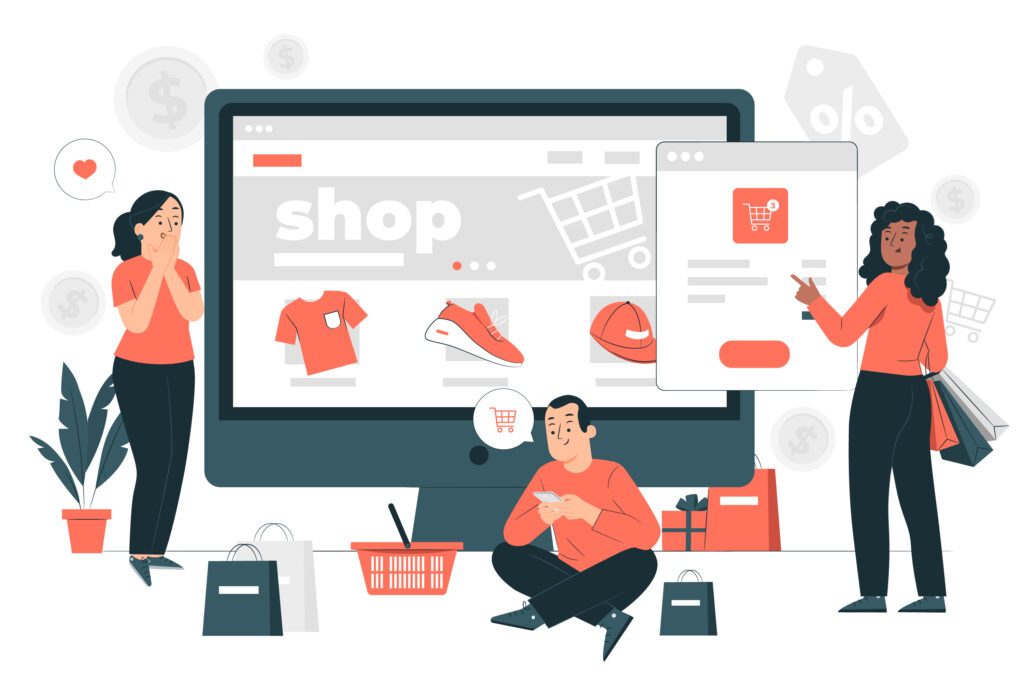
Key Takeaways
- Web design is the process of planning, conceptualizing, and arranging content intended for the internet.
- 2023 ecommerce web design trends prioritize user-centered approaches like interactive 3D/AR, minimalism, dark mode, mobile-first, microinteractions & manymore.
- Effective ecommerce web design enhances user experience, aids product discovery, and boosts conversion, while poor design can frustrate users and drive them away.
- Challenges in ecommerce web design include complex layouts, checkout complications, balancing creativity, usability, & lack of testing.
Website design is a cornerstone of eCommerce, acting as the virtual storefront for businesses.
Its quality impacts many factors, from brand image and user experience to search engine optimization, thus directly influencing customer engagement, conversion rates, and overall online visibility.
As we enter 2023, a shift towards more interactive and personalized designs dominates eCommerce web design trends.
These user-centric approaches enhance user experience and engagement, proving crucial for eCommerce success in today’s competitive online marketplace.
Ecommerce web design for businesses

Web design is the process of planning, conceptualizing, and arranging content intended for the Internet.
It encompasses several aspects, including webpage layout, content production, and graphic design.
The design and functionality of eCommerce sites, coupled with efficient web development packages, are critical in determining a user’s first impression of a business, shaping their understanding of the brand, and influencing their interaction with the site.
An eCommerce website development can enhance the experience, making it easy for customers to find, learn about, and purchase products.
A poorly designed site, however, can frustrate users, potentially driving them to competitors.
Furthermore, web design impacts a website’s search engine optimization (SEO) performance, affecting its visibility to potential customers.
Therefore, effective web design is critical to driving traffic, retaining good customer reviews, and boosting sales in an eCommerce setting.
9 eCommerce web design trends for 2023

The following eCommerce web design trends will help to get your business more conversions and engagement on your site:
1. Minimalistic design
This eCommerce web design trends embraces the “less is more” principle.
It is about stripping away the non-essential elements and focusing on what is truly important. It prioritizes simplicity, functionality, and user-friendly interfaces.
To implement a minimalistic design, businesses should create a clean, uncluttered layout highlighting the products.
White space can be strategically used to draw focus to specific elements, while typography should be simple and legible to improve readability.
An excellent example is Apple’s online store, known for its sleek, clean design.
2. Interactive 3D & Augmented reality (AR)
In today’s world one of the best eCommerce website development services trends is AR. This technology revolutionizes how customers interact with products online.
With AR, customers can visualize products in their environment, giving them a more realistic understanding of the product.
For instance, IKEA’s AR app, IKEA Place, allows customers to see how a piece of furniture would look and fit in their own space.
This not only improves the shopping experience but also helps in making informed purchasing decisions.
Ecommerce businesses can leverage AR technology to improve product visualization, whether furniture, clothing, or cosmetics.
3. Dark mode
One of the eCommerce web design trends is Dark mode. It is a user interface design with a dark color theme.
It offers an alternative interface that can reduce screen glare, thus reducing eye strain for users, especially in low-light conditions.
Furthermore, dark mode can save battery life on OLED screens.
Ecommerce businesses can offer a dark mode option in their website settings to cater to customers who prefer this mode, enhancing user experience and accessibility.
4. Mobile-first design
With the ever-growing mobile shopping trend, eCommerce businesses must prioritize mobile-friendly design.
This strategy involves designing the website for smaller screens first and then scaling up for larger devices.
It involves easy-to-use navigation, quick loading times, and clear product images to ensure a smooth mobile shopping experience.
Businesses can test their website on various devices and screen sizes to ensure mobile responsiveness.
For a smooth mobile shopping experience, a web developer service can help create a responsive design that works seamlessly across all devices.
5. Micro interactions
Micro interactions are subtle animations or design elements that guide tasks, provide feedback, or help users interact with the website.
They can be as simple as a color change when a button is clicked, a subtle bounce when a product is added to the cart, or a progress indicator during a file upload.
These small interactions make the user experience more satisfying and intuitive.
By leveraging user experience services, companies can ensure their micro-interactions are effectively enhancing the overall customer journey.
6. Storytelling through visuals
Visual storytelling conveys a narrative through images, videos, infographics, or animations.
In eCommerce, this narrative can be about the brand’s values, the features of a product description, or the story behind a product’s creation.
Visual storytelling can evoke emotions and connect with customers beyond the simple transaction of buying a product.
Using an AI image generator, businesses can bring their ideas to life, producing tailored visuals that help tell their brand story in a more compelling way.
Tools like NovelAI image generation are particularly effective in this space, offering advanced capabilities to create unique, story-driven visuals that align with a brand’s identity and messaging.
Companies can integrate high-quality images into their websites, but they may need to increase the size of the PDFs to accommodate these visually rich elements.
To implement this, businesses can use compelling visuals that tell a story on their product pages, about us pages, or even as part of their social media strategy.
7. Scrolling animations
Scrolling animations are web animations triggered by the user’s scroll action.
They can add a sense of depth, surprise, or engagement to a webpage, making the browsing experience more dynamic and interactive.
They can reveal content progressively, direct attention, or provide feedback.
Businesses looking to implement scrolling animations should ensure they are used to enhance the user experience and not distract or slow down the website.
You can create captivating animations for your business with user-friendly animation maker tools that align with your brand identity and help increase online engagement.
8. AI & machine learning personalization
Artificial Intelligence (AI) and machine learning are increasingly used to create personalized shopping experiences.
These technologies analyze a customer’s browsing history, previous purchases, and other online behaviors to predict what products they might be interested in.
Businesses can leverage AI & machine learning tools to analyze customer data and deliver highly personalized product recommendations, similar to how Netflix recommends shows based on users viewing history.
9. Voice user interface (VUI)
With the rise of voice-activated assistants like Amazon’s Alexa, VUI is becoming more prevalent in eCommerce.
It allows users to interact with a website through voice commands, enabling them to search for products, place orders, and track deliveries, making the shopping experience even more convenient.
To incorporate VUI, eCommerce businesses can integrate voice-activated features in their websites or apps, ensuring their platforms are compatible with voice assistants.
Challenges & solutions in eCommerce website design
The following analysis shows common challenges with e-commerce website design and how to overcome them.
| Design Challenge | Solution |
| Complex layouts | Ensure smooth navigation through a straightforward, intuitive navigation menu, easy-to-find search bars, and well-organized categories |
| Complicated checkout process | Simplify the checkout process by reducing the steps needed to complete a purchase, offering guest checkout options, and providing clear information about shipping and returns |
| Balancing creativity and usability | Strike a balance between incorporating unique, creative elements and ensuring the site is user-friendly. This can involve using engaging visuals and unique layouts while ensuring that the site loads quickly, is easy to navigate, and is accessible to all users |
| Lack of user experience testing | Regularly conducts user experience testing to gather insights and make necessary improvements |
| Not keeping up with trends & technological advancements | Keep the website design updated based on the latest trends. |
| Ignoring user feedback and analytics | Collect and analyze user feedback to make data-driven design decisions. |
Conclusion
Ecommerce web design trends 2023 represent a dynamic shift towards user-centric and interactive experiences.
This ranges from minimalistic designs offering usability and comfort to the implementation of AR for enhanced product visualization and AI for personalized experiences.
Additionally, the importance of mobile-first design, voice user interface, and the inclusion of micro interactions and dark mode options underscore the move towards more inclusive, accessible design approaches.
However, it’s crucial to note that as technology evolves and customer preferences change, the need for continuous innovation and adaptation in eCommerce web design trends becomes even more significant.
By doing so, they can create an online shopping experience that meets and exceeds customer expectations, ultimately ensuring their success in the highly competitive eCommerce landscape.
